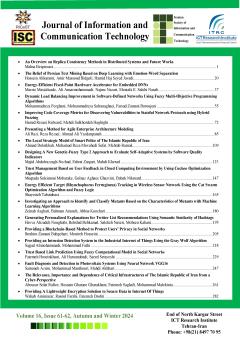ردیابی هدف (سوسک سرخرطومی خرما) انرژی کارا در شبکه حسگر بی سیم با استفاده از الگوریتم ازدحام گربه و منطق فازی
الموضوعات : ICT
1 - هیات علمی دانشگاه
الکلمات المفتاحية: خوشه بندي, مصرف انرژي, شبکه هاي حسگر بي سيم, الگوریتم بهینه سازی ازدحام گربه ها, منطق فازی, ردیابی هدف متحرک, سوسک سرخرطومی خرما. ,
ملخص المقالة :
آفت سوسک سرخرطومی حنایی عامل ورود بیماری¬های باکتریایی و قارچی به نخل می¬باشد که در صورت مشاهده در مزارع، خسارت سنگینی به نخلستان¬ها وارد می¬کند. امروزه تحول در محیط ارتباطات بی¬سیم امکان توسعه گره¬های حسگر کم هزینه، کم مصرف، چند عملکردی و کوتاه برد جهت ردیابی این آفت در نخلستان را فراهم آورده است. در الگوریتمهای ردیابی هدف موجود، با افزایش سرعت هدف، احتمال از دست دادن هدف نیز افزایش می¬یابد. بر این اساس در مقاله حاضر روش جدیدی برای ردیابی هدف پیشنهاد می¬شود که از دست دادن هدف را کاهش می¬دهد. از طرفی با توجه به محدودیت انرژی سطح باتری در گره¬های حسگر، نیازمند برنامه زمانی برای دوره خواب و بیداری حسگرها در راستای افزایش طول عمر شبکه هستیم. به منظور بهبود مصرف انرژی در این مقاله از رویکرد برنامه¬ریزی زمانی جهت تنظیم دوره خواب و بیداری گره¬ها با استفاده از الگوریتم بهینه¬سازی ازدحام گربه و منطق فازی استفاده شده است. از شبيه سازی روش پیشنهادی و مقایسه آن با روش Tracking-45-Degree-vectors در شبیه ساز Opnet می¬توان دریافت که پروتکل پیشنهادی عملکرد بسیار بهتری دارد، بطوریکه نرخ تأخیر انتها به انتها به میزان 02/27 درصد، نرخ تأخیر دسترسی به رسانه به میزان 01/2 درصد، نرخ گذردهی به میزان 62/0 درصد، نسبت سیگنال به نویز به میزان 28/3 درصد و ميانگين انرژي مصرفي باتری به میزان 277/8 درصد نسبت به پروتكل Tracking-45-Degree-vectors بهبود یافته است. لازم به ذکر است الگوریتم پیشنهادی برای یک هدف شبیه سازی و تست شده است.
Simon, G., Maróti, M., Lédeczi, Á., Balogh, G., Kusy, B., Nádas, A., ... & Frampton, K. (2004, November). Sensor network-based countersniper system. In Proceedings of the 2nd international conference on Embedded networked sensor systems (pp. 1-12).
Tabatabaei, S. (2021). A Novel Method for Optimizing Energy Consumption in Applications for Detecting Palm Rhynchophorus Ferrugineus in WSNs Using Data mining and Q-Learning. Wireless Personal Communications, 121(1), 1-17.
عباسی ج،. دبیری ح،. امیری ع،. " آفت قرنطینه ای سرخرطومی حنایی خرما "، ج 1، انتشارات مدیریت هماهنگی ترویج کشاورزی استان فارس، ص 14، بهار 1396 https://agrilib.areeo.ac.ir/book_3292.pdf.
Lima, M. C. F., de Almeida Leandro, M. E. D., Valero, C., Coronel, L. C. P., & Bazzo, C. O. G. (2020). Automatic detection and monitoring of insect pests—A review. Agriculture, 10(5), 161.
Suganya, S. (2008, July). A cluster-based approach for collaborative target tracking in wireless sensor networks. In 2008 First International Conference on Emerging Trends in Engineering and Technology (pp. 276-281). IEEE.
Wang, Z., Li, H., Shen, X., Sun, X., & Wang, Z. (2008, April). Tracking and predicting moving targets in hierarchical sensor networks. In 2008 IEEE International Conference on Networking, Sensing and Control (pp. 1169-1173). IEEE.
Balasubramanian, S., Jayaweera, S. K., & Namuduri, K. R. (2005, March). Energy-aware, collaborative tracking with ad-hoc wireless sensor networks. In IEEE Wireless Communications and Networking Conference, 2005 (Vol. 3, pp. 1878-1883). IEEE.
Li, D., Wong, K. D., Hu, Y. H., & Sayeed, A. M. (2002). Detection, classification, and tracking of targets. IEEE signal processing magazine, 19(2), 17-29.
Liu, H. Q., So, H. C., Chan, F. K. W., & Lui, K. W. K. (2009). Distributed particle filter for target tracking in sensor networks. Progress In Electromagnetics Research C, 11, 171-182.
Madhavi, K. R., Nawi, M. N. M., Reddy, B. B., Baboji, K., Kishore, K. H., & Manikanthan, S. V. (2023). Energy efficient target tracking in wireless sensor network using PF-SVM (particle filter-support vector machine) technique. Measurement: Sensors, 26, 100667.
Xiang, S., & Yang, J. (2023). A novel adaptive deployment method for the single-target tracking of mobile wireless sensor networks. Reliability Engineering & System Safety, 234, 109135.
Qu, Z., Xu, H., Zhao, X., Tang, H., Wang, J., & Li, B. (2022). A fault-tolerant sensor scheduling approach for target tracking in wireless sensor networks. Alexandria Engineering Journal, 61(12), 13001-13010.
Munjani, J., & Joshi, M. (2021). A non-conventional lightweight Auto Regressive Neural Network for accurate and energy efficient target tracking in Wireless Sensor Network. ISA transactions, 115, 12-31.
Sahoo, B. M., Pandey, H. M., & Amgoth, T. (2022). A genetic algorithm inspired optimized cluster head selection method in wireless sensor networks. Swarm and Evolutionary Computation, 75, 101151.
Sadrishojaei, M., Navimipour, N. J., Reshadi, M., & Hosseinzadeh, M. (2022). A new clustering-based routing method in the mobile internet of things using a krill herd algorithm. Cluster Computing, 25(1), 351-361.
Srinivas, P., & Swapna, P. (2022). Quantum tunicate swarm algorithm based energy aware clustering scheme for wireless sensor networks. Microprocessors and Microsystems, 94, 104653.
Amutha, J., Sharma, S., & Sharma, S. K. (2022). An energy efficient cluster based hybrid optimization algorithm with static sink and mobile sink node for Wireless Sensor Networks. Expert Systems with Applications, 203, 117334.
Mansour, R. F., Alsuhibany, S. A., Abdel-Khalek, S., Alharbi, R., Vaiyapuri, T., Obaid, A. J., & Gupta, D. (2022). Energy Aware Fault Tolerant Clustering with Routing Protocol for Improved Survivability in Wireless Sensor Networks. Computer Networks, 109049.
Kaedi, M., Bohlooli, A., & Pakrooh, R. (2022). Simultaneous optimization of cluster head selection and inter-cluster routing in wireless sensor networks using a 2-level genetic algorithm. Applied Soft Computing, 128, 109444.
Malisetti, N., & Pamula, V. K. (2022). Energy efficient cluster based routing for wireless sensor networks using moth levy adopted artificial electric field algorithm and customized grey wolf optimization algorithm. Microprocessors and Microsystems, 93, 104593.
Chu, S. C., Tsai, P. W., & Pan, J. S. (2006). Cat swarm optimization. In PRICAI 2006: Trends in Artificial Intelligence: 9th Pacific Rim International Conference on Artificial Intelligence Guilin, China, August 7-11, 2006 Proceedings 9 (pp. 854-858). Springer Berlin Heidelberg.
Zadeh, L. A. (1965). Fuzzy sets. Information and control, 8(3), 338-353.


